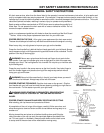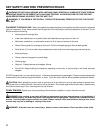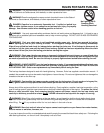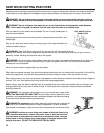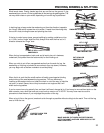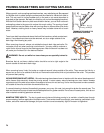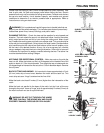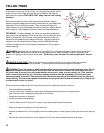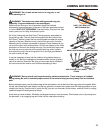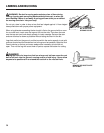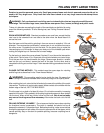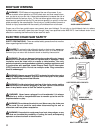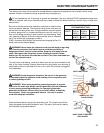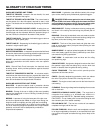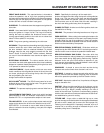
35
FRONT HAND GUARD - This required device is intended to
reduce the operator’s risk of injury from projecting branches
and saw-chain contact with the left hand in the event the operator
loses his grip from the upper part of the handle. Do not operate
a chain saw with a loose or broken hand guard.
GUIDE BAR - The railed structure that supports and guides the
saw chain.
HINGE - Uncut wood which holds the tree from twisting off the
stump and guides or “hinges” its fall. The hinge is formed by
making the back cut towards the directional control notch,
coming approximately parallel to the notch but no closer than
about 2 inches (about 51 mm) away.
KERF- The groove opening produced by the chain saw.
KICKBACK - The general term describing two highly dangerous
reactions which can occur. When used alone in this manual,
the term “kickback” refers to rotational kickback. To prevent
kickback, keep the bar nose properly covered with the Kick
Guard
®
device. If the Kick Guard
®
device is absent, kickback
can occur if the unshielded bar nose touches an object or the
ground.
ROTATIONAL KICKBACK - The violent reaction which can
occur when the chain at the upper section of the nose is suddenly
stopped or impeded, thereby dangerously driving the bar nose
in an upward arc toward the operator.
LINEAR KICKBACK - A push reaction, which can occur under
certain conditions with the guide bar buried in the cut when the
cut closes, pinching the chain along the top rails of the guide
bar and propelling the chain saw
straight back toward the operator.
KICK GUARD
®
DEVICE - The ECHO brand name for its anti-
kickback device which covers the bar nose. The generic name
for such a device is “bar tip guard.”
LIMBING - The process employing cuts to remove limbs from a
tree.
LOW-KICKBACK SAW CHAIN - A saw chain which has been
demonstrated to meet the kickback requirements of ANSI
Standard B 175.1 on a representative sample of chain saws.
FELLING NOTCH - A vee or other shape cutout made at right
angles to the desired line of fall on the side the tree is to fall.
SIDE NOTCH - A cut made on one or both sides of the trunk
either to reduce the chance of splitting, or as part of the Apple
Core Method.
PINCH - Specifically the closing-in of the wood which
pinches and stops the chain along the top rails of the guide bar
during a cut. This can result in the chain saw being propelled
straight back toward the operator (called a Linear Kickback).
Pinch can also occur on the lower rails of the bar, resulting in
the chain saw being pulled away from the operator.
PLUNGE CUTTING - Another term for Boring with a chain saw.
See definition of Boring.
PRUNING - The process of trimming branches on a living tree.
PUSH AND PULL - When cutting is done along the bottom rails
of the guide bar, the reaction on the saw is a pull away from the
operator. When the top of the guide bar is used, the reaction
pushes the saw towards the operator. Both are normal reactions
which must be controlled by the operator.
REDUCED-KICKBACK GUIDE BAR - Guide bars which are
recognized by the ANSI Standard B175.1 as having as small or
reduced radius nose to reduce the potential kickback area.
REDUCED-KICKBACK SAW CHAIN - Saw chain which has
been demonstrated to reduce kickback on a selected group of
chain saw models during ANSI testing. Before using “reduced
kickback” chain, ask your ECHO dealer to determine if your
chain saw can accommodate “reduced-kickback” chain and still
meet the 45-degree CKA requirement.
SCABBARD - A sheath to cover the chain and bar during
transport and at other times when the saw is not in use.
SCYTHING - A sweeping, close-to-ground action with the saw
blade to remove brush and weeds. Scything must not be done
without the protection provided by the Kick Guard
TM
device.
SIDE LINE - Attached to a tether line, it is pulled at a 90 degree
angle to the tether line.
SKATING - When the chain saw fails to dig in during a cut, the
guide bar can begin hopping or dangerously skidding along the
surface of the log or branch, possibly resulting in the loss of
control of the chain saw. To prevent or reduce skating, properly
hold the chain saw with two hands and make sure the saw chain
has established a groove for cutting.
TETHER LINE - A rope, chain or cable tied high up on a tree
trunk for leverage, and used to tether the tree against a backward
fall and to exert a steady pull to ensure the tree’s proper fall.
Tethering can be dangerous if improperly executed, such as if
a tether line is not strong enough to withstand the pull, or the
available pulling force is inadequate.
GLOSSARY OF CHAIN SAW TERMS



